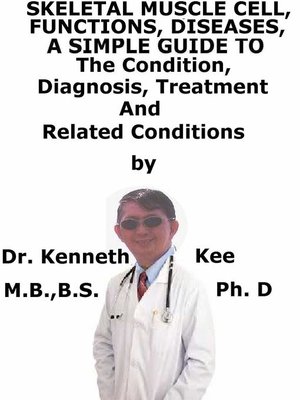Skeletal Muscle Diseases, a Simple Guide to the Condition, Diagnosis, Treatment and Related Conditions
ebook
By Kenneth Kee

Sign up to save your library
With an OverDrive account, you can save your favorite libraries for at-a-glance information about availability. Find out more about OverDrive accounts.
Find this title in Libby, the library reading app by OverDrive.



Search for a digital library with this title
Title found at these libraries:
| Loading... |
This book describes Skeletal Muscle Diseases, Diagnosis and Treatment and Related Diseases
Skeletal muscles completely cover the whole human skeleton working to support the skeleton and move the bones in the body.
They are attached to the skeleton by strong, springy tendons or are directly joined to rough patches of bone.
Skeletal muscles are under voluntary control, which means the person consciously controls what they do.
Muscles are mainly powered by the oxidation of fats and carbohydrates but anaerobic glycolysis are also utilized mostly by fast twitch fibers.
These chemical reactions form adenosine triphosphate (ATP) molecules which are utilized to power the movement of the myosin heads.
Skeletal muscle or voluntary muscle is attached by tendons to bone and is utilized to effect skeletal movement such as locomotion and in retaining the posture.
An average adult male is made up of 42% of skeletal muscle as a proportion of body mass and an average adult female comprises 36%.
Striated muscle tightens and loosens in short, intense bursts while smooth muscle maintains longer or even near-permanent contractions.
Skeletal (voluntary) muscle is further classified into 2 broad types:
1. Type I, slow twitch or red muscle, is heavy with capillaries and is rich in mitochondria and myoglobin giving the muscle tissue its typical red color
2. Type II, fast twitch muscle, has 3 major subtypes (IIa, IIb, and IIx) that differ in both contractile speed and force generated.
Fast twitch fibers contract rapidly and powerfully but fatigue occurs in very rapidly sustaining only short, anaerobic bursts of activity before muscle contraction becomes painful.
They supply most to muscle strength and have greater possibility for increase in mass.
Type IIb is anaerobic, glycolytic, white muscle that is least heavy in mitochondria and myoglobin.
This is the main fast muscle type with low density that explains the pale color of their flesh.
Muscles require oxygen and food for energy from the blood in order to work properly.
If they function hard but do not get enough oxygen and food, they may go into a spasm and the body will feel the pain of a cramp
A person has all the muscle fibers he or she will ever need at birth.
Once injured, they can not be replaced.
Muscle sprains and strains may occur from injury and overuse of the muscles
Cramps can occur when muscles are unable to relax properly due to myosin fibers not fully detaching from actin filaments.
Other causes are dehydration, low levels of certain minerals, poor blood flow to the muscles.
Sarcopenia is a medical disorder which occur as a result of age causing loss of muscle mass and function.
From the time the person is born to around the time he or she turns 30, the muscles grow larger and stronger.
But at some point in the 30s, the person start to lose muscle mass and function, a condition known as age-related sarcopenia or sarcopenia with aging.
Any loss of muscle mass indicates loss of strength and mobility.
Hormone replacement therapy has been found to improve lean body mass only together with exercise.
Fibromyalgia is a chronic disorder featured by extensive muscle pain, stiffness, fatigue, and tenderness in localized areas.
Fibromyalgia has also been linked to fatigue, sleep problems, headaches, depression and anxiety.
Treatment is by local injections of steroids, anti-epileptic drugs, muscle relaxants and antidepressants.
Polymyositis and dermatomyositis are autoimmune connective tissue diseases characterized by inflammation of muscles.
While dermatomyositis affects the skin and...






